Abstract
The mesoscale circulation along the west shore of Spitsbergen is largely controlled by the difference in temperature between the glaciers and surface sea temperatures. We describe how the mesoscale effect influences the atmospheric circulation patterns. The conducted research was based on reanalysis data, model data, and atmospheric measurements; wind data from different sources and scales were compared and analysed. We discuss the situations wherein the mesoscale effect can be identified by analysing the wind direction or its velocity. This study shows the role of the mesoscale effect on the wind in the Svalbard region. Different situations according to the atmospheric patterns taken from a catalogue of 21 circulation types for each day created for Svalbard are analysed and compared with cases of land-sea breeze type circulation for the 20-year period between 1994 and 2013. It is proved that even if it is not possible to distinguish this mesoscale effect based on the difference between local and large-scale wind directions, this factor can be observed by studying the wind speeds. It is claimed that as long as there are glaciers on Spitsbergen, there will be a mesoscale land-sea breeze type circulation controlled by the difference in air temperature over land and water.
1. Introduction
The Arctic is the Earth’s region where changes in the climate are most rapid and visible, changes which have and will continue to have severe impact on environment and society and in last years and have caused an increase of interest on the ocean role in climate shaping. Atmospheric circulation, next to the oceans, has a huge impact on the climate. An excellent laboratory for observing the changes taking place on account of, inter alia, its availability is Svalbard and its surroundings. The Svalbard archipelago (whose largest island is Spitsbergen), along with several islands that are not part of the archipelago (including Bear Island-Bjørnøya), is located within the limits of 71°–81° N and 10°–35° E, 800 km north of Norway and 1100 km from the North Pole. The climate of Svalbard is mainly determined by its proximity to the North Atlantic current, which makes the surrounding waters of the Greenland Sea ice-free in the west of the island. Its climate is sub-polar along the west coast and polar on the east coast. The literature on Svalbard’s meteorology is constantly evolving [1], even if many aspects are yet to be fully understood.
There are several studies confirming a strong relationship between the atmosphere, ocean, and ice cover near the Svalbard Archipelago [2], which shows a profound influence of atmospheric conditions on the West Spitsbergen Shelf hydrography via the cross-shelf Ekman transport. The increasingly important role of the atmospheric thermodynamic force in shaping recent changes in the Svalbard multiyear ice is also evident [3]. There are strong inverse relationships between near-surface wind speed and sea ice concentration, confirmed by comparing results from several different analyses and the results from climate models [4]. Atmospheric forcing of the circulation is important for determining salinity in the North Atlantic and there is a close relationship between conditions on the shelf and slope of the Northwest Atlantic, on the one hand, and the winds directing the inflow of Arctic freshwater, on the other [5]. Increasing winds, along with sea ice reduction, sea level rise, and melting permafrost, are another major factor contributing to the growing problem of Arctic coastal erosion [6]. A statistical analysis and comprehensive description of the Arctic winds climatology over the ocean is provided by [7], who also point that this is an inseparable part in the heat exchange process between the sea and the atmosphere.
The influence of local conditions on wind circulation cannot be overlooked. Based on observations in one of the fjords of the west coast of Spitsbergen, Isfjord, it was found that there is a strong correlation between the along-shelf wind direction and the direction of wind stress operating locally on the fjord, as local wind action drives the two-layer cross-fjord circulation patterns through the surface Ekman transport [8]. Another local phenomenon is katabatic winds [9], whose effect on the shelf-fjord exchange mechanism (inflow of warm saline water in the deeper layers and outflow of glacial freshwater in the upper layer) has been described based on studies in the fjords of the east coast of Greenland by [10]. Results from a high-resolution numerical model of ocean circulation confirm that such water circulation also occurs in Kongsfjord (fjord in west coast of Spitsbergen). According to [11], fresh water discharge from glaciers is not a necessary factor forcing exchange under the water surface, a more important influence are winds blowing along the fjord axis. The occurrence of a breeze front over the West Spitsbergen current is also confirmed by measurements of aerosol optical depth AOD [12]. In our previous work [13], it was well proven that land-sea breeze type circulation is a mesoscale phenomenon and thus should be considered over the entire Svalbard. The force causing the air circulation due to the difference in temperature occurs all seasons and all times of the day, since the waters of the Arctic Ocean in this region are usually free of sea ice, so their surface is warmer than the neighbouring glaciers on the island, such that the temperature difference is always there regardless of the time of day and year. However, this phenomenon is most often observed in the winter months (the highest probability of a land-sea breeze type circulation occurring simultaneously in Hornsund and Kongsfjorden is in February and March), while it is least probable during summer. This is due to the fact that surface water temperatures in the unfrozen waters of the West Spitsbergen Current flowing west of the island are never higher than approx. 3 °C [14] and in summer the temperature difference between the glaciers in the east and the open water is the lowest. At the same time, it is not always easy or even possible to demonstrate the existence of this type of circulation. Analysis of wind direction at measuring stations and large-scale wind allows us to identify conditions that are dominated by the mesoscale factor. In addition, in this work we want to show that also in situations where the wind direction does not differ, the influence of the mesoscale factor can be identified on the basis of the difference between local and large-scale wind speed.
The research paper presented here can be regarded as an extension and partly a supplement to the previous work [13], in which the land-sea breeze type circulation in the West Spitsbergen fjords is described. Additionally, it is shown that this type of circulation is mesoscale and simultaneously affects fjords located at opposite ends of the island. The aim of this work is to analyze synoptic situations that favor the occurrence of such a circulation and enable its detection, which is based so far on the study of the wind direction measured at stations in the fjords and the wind resulting from the large-scale pressure field. One new feature is that we analyze wind speed and air temperature. Furthermore, the realized goal of this work was to investigate and find how the mesoscale factor influences the formation of synoptic situations.
2. Materials and Methods
The measured data are from two research stations located in the Kongsfjorden and Hornsund fjord (highlighted in Figure 1). Although both fjords are located on the west coast of Spitsbergen (the largest island in the Svalbard archipelago) with latitudes that are only 2 degrees apart, they have different climatic conditions [15]. However, the key point here for us is that both fjords to the east of the measurement stations have glaciers and often snow or ice cover, while to the west of the fjords and the entire island is the Arctic Ocean with the Greenland Sea, through which the West Spitsbergen Current carries the warmer Atlantic water.
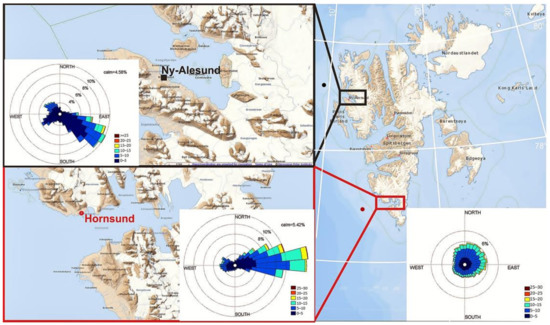
Figure 1.
Map of research area: Spitsbergen, the main island of the Svalbard archipelago with insets showing the two discussed fjords. Local wind roses for Ny-Ålesund station for the years 1992–2013, for Hornsund station for the years 1993–2013 and large-scale wind rose (from NCEP/NCAR reanalysis) for the years 1992–2013 are presented [13]. Dots on the right map are selected points in the open sea of about 60 km from the stations, with coordinates: 79.125° N, 9.125° E and 76.875° N, 13.250° E.
In this paper, we compare four types of data, each with a different scale: (i) wind resulting from the large-scale pressure field in data from the NCEP/NCAR reanalysis (referred to in this work as large-scale wind) [16,17]; (ii) air temperature and wind data from the Era-Interim reanalysis (here called the mid-scale); (iii) synoptic situations from Niedźwiedź Svalbard circulation calendar [18]; and (iv) wind in the fjord research station (referred to as local). Mid-scale data and synoptic data may differ only slightly in scale, but the key difference is these data’s separate sources. We consciously use models of different scales since conclusions can be drawn based on the observed and analysed differences. The analyses presented in this work cover a period of 20 years, from 1 January 1994 to 31 December 2013.
The calendar of atmospheric circulation types for Spitsbergen is based on synoptic maps of Europe. The description lists 21 types of circulation CT and divides them, depending on the type of pressure pattern, into cyclonic (c) and anticyclonic (a) (10 CT each). The direction of air mass advection, i.e., geostrophic wind, is indicated by the letters (N, NE, E, etc.). Situations are labelled apart: Ca, central anticyclone situation (high centre); Ka, anticyclonic wedge or ridge of high pressure; Cc, central cyclonic situation (centre of low); Bc, trough of low pressure (different directions of air flow and frontal system in the axis of the trough). The twenty-first type of circulation is marked with an x and indicates unclassified situations or pressure col. This is explained in detail in [19].
In this work we analysed data from WMO network stations located in the fjords of Western Spitsbergen, i.e., Hornsund and Kongsfjorden (Ny-Ålesund), collected with WMO-standard compliant devices, while automatic stations have also been used in recent years. The data used are the measurements of wind for a period of 20 years at 10 m height and 6 h time resolution include 29,219 datapoints from the Polish Polar Station in Hornsund and 28,612 datapoints from the AWIPEV station, the joint French-German Arctic Research Base – the German Alfred Wegener Institute for Polar and Marine Research (AWI), and the French Polar Institute Paul Emile Victor (IPEV) in Kongsfjorden [20]. The six-hourly local wind data are the result of temporal 10 min averaged measurements that also accord with WMO standards. In this work we used the land-sea breeze type circulation events identified in [13], using a comparison of local wind data and 10 m winds from the NCEP/NCAR 2.5° × 2.5°, six-hourly, reanalysis [21]. The choice of the low-resolution NCEP/NCAR reanalysis was not random. The low-density grid minimizes the effect of contaminating the large-scale wind field with assimilated local wind data influenced by the very phenomena under study, allowing us to use it as a large-scale circulation. A high-resolution model could resolve the studied mesoscale orographic and thermal phenomena instead of representing the large-scale circulation.
Air temperature values for the 20-year study are from the Era-Interim 0.125° × 0.125°, 6-hourly, reanalysis [22]. 2 m temperature is calculated by interpolating between the lowest model level and the Earth’s surface, taking account of the atmospheric conditions [23], who compares air temperature measurements from ground-based weather stations, drifting buoys and the North Pole drifting stations, shows the insignificant overestimation of 2 m temperature in the ERA-Interim reanalysis compilation with observations from coastal stations (the bias does not exceed 0.5 °C), i.e., data from the ground-based meteorological stations are assimilated quite effective. However, the discrepancy between the reanalysis and drifting buoys observations is greater and ranged from −6.95 °C to 0.78 °C and depend on the type of buoy used and the season-in the cold season the difference is much greater. It is also claimed that observational data from the buoys are less reliable than the results of the modeling.
Results were achieved by comparisons of wind data collected in measurement stations which are directed under the strong influence of topography, with large-scale data from reanalysis with spatial resolution high enough (2.5° × 2.5°) to exclude the influence of the island and its orography. The effect of topography on wind is clearly visible in the wind roses for stations in fjords (Figure 1), which show that the wind blows mostly along the fjord axis regardless the large-scale wind field. Situations identified as land-sea breeze type circulation events are those where the wind measured at station is from the east while a large-scale pressure field indicates the wind from the west. The head of Hornsund fjord azimuth is at approximately 90 deg. and east winds are defined within a range of 0–180 deg. However, Kongsfjorden has a head axis pointing northwest-southeast (head of fjord azimuth at approximately 120 deg. direction) and to find land-sea type breeze circulation events, the range of wind directions measured at the station in Ny-Ålesund was also changed by 30 deg., i.e., 30–210 deg.
3. Results
The analysed situations are those where it is possible to detect the dominance of a mesoscale factor over a large-scale factor [13], shows that the local winds are largely independent of large-scale circulation direction. This phenomenon is called land-sea breeze circulation—the circulation between the ice-free sea areas of the warm Spitsbergen current in the west and the much colder glaciers in the east.
3.1. Synoptic Circulation Patterns
Most situations that we identify in our work as the land-sea breeze type circulation events in the fjords of the Western Spitsbergen were observed at a time when the atmospheric circulation pattern as described according to the calendar of Svalbard circulation [18] was one of the eastern type. Nearly 38% of the cases occurred during East (20%) and South-East (18%) cyclonic types of circulation. During the North-East cyclonic and East anticyclonic types of circulation, cases were about 10% each (Figure 2). As can be seen in Figure 3, in as many as 60% of synoptic situations with SEc advection direction, a land-sea breeze type circulation was detected. The same happened in cases of Ec (52%), Ea (47%) and SEa (45%) type of circulations. This shows that the mesoscale factor has a decisive influence on almost half of the synoptic situations causing advection from east directions. Meanwhile, one can clearly see that while the synoptic situation was a western circulation (i.e., West, South-West, North-West anticyclonic and cyclonic), the number of observed land-sea breeze type circulation events (detected by comparing wind directions at different scales) was approaching zero. This is mainly due to the fact that the phenomenon is not observed in western circulations since in such a case the direction of the large-scale wind and that of the wind measured at the station (driven by the local conditions) are concurrent, while the basis for marking the case as a land-sea breeze type circulation is the opposing direction of these winds. Moreover, during the period under study (and in general), the Spitsbergen region is less frequently affected by the western and southern type of circulation (e.g., [18,24]) (Figure 2a). In such synoptic situations, the land-sea breeze type circulation is more difficult to notice. As the circulation is more often eastern, most cases are detected. When there are no clear pressure gradients, i.e., when there is a ridge, trough, high or low centre (Ca, Ka, Cc, Bc—on Figure 2), the analysed phenomenon is also visible, much better than in situations that mask it, i.e., western type circulation.
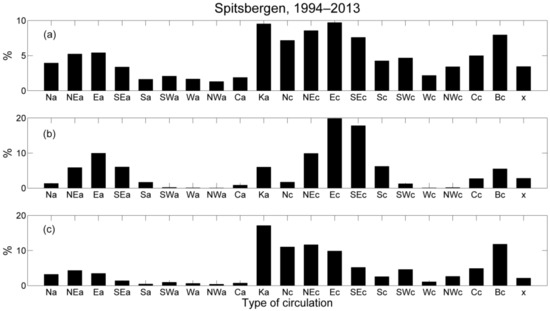
Figure 2.
Distribution of types of synoptic situations (circulation types): (a) during the entire studied period in Svalbard, 1994–2013; (b) when the mesoscale land-sea breeze type circulation was recorded in Hornsund and Ny-Ålesund at the same time; (c) when the mesoscale land-sea breeze type circulation was not visible. 100% is all measurements when this factor is observed. 100% is all measurements when this factor is observed.
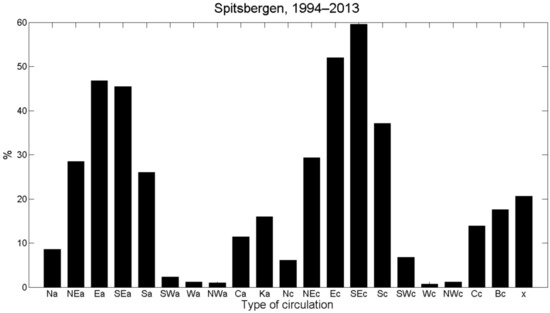
Figure 3.
The conditional probability of the mesoscale land-sea breeze type circulation in each type of circulation (from Figure 2a), 1994–2013.
The study area was dominated by east direction of the circulation types throughout the year, regardless of whether a mesoscale land-sea breeze type circulation was recoded or not. No major seasonal differences were found [19], and a quantitative assessment of differences in atmospheric circulation patterns during warming and cooling periods on Spitsbergen (mainly for autumn and winter) is presented.
Eastern types of circulation not only favour land-sea breeze type circulation; it is very possible that it is caused by this mesoscale phenomenon. Figure 3 shows how much the mesoscale land-sea breeze type circulation can affect. If almost 60% of the SEc circulation is associated with the presence of mesoscale circulation, which means that it has impacted it.
3.2. Wind Speed Distribution
Figure 4 shows that the wind measured in the station located in Hornsund (while there is a land-sea breeze type circulation detected by comparing wind directions at different scales) usually blows at 6–8 ms−1. This is 17.4% of the observed cases with the land-sea breeze type circulation events. At the same time, in the Ny-Ålesund station in Kongsfjorden, this wind speed corresponds to only 10.7% of cases, and most of the events with land-sea breeze type circulation in Kongsfjorden are observed with the weakest wind, i.e., less than 2 ms−1, representing over 30% of all situations (30.5%). During strong winds (>20 ms−1) of large scale (Figure 5) and in those measured at stations in fjords, single land-sea breeze type circulation events were recorded. This is not observed during wind speed higher than 25 ms−1.
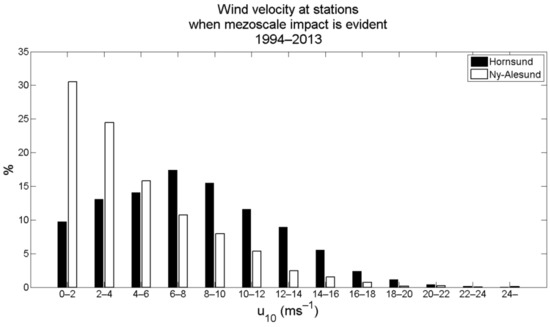
Figure 4.
The distribution of wind speed at Hornsund and Ny-Ålesund stations when the mesoscale land-sea breeze type circulation was recorded, 1994–2013. Black—Hornsund, white—Ny-Ålesund.
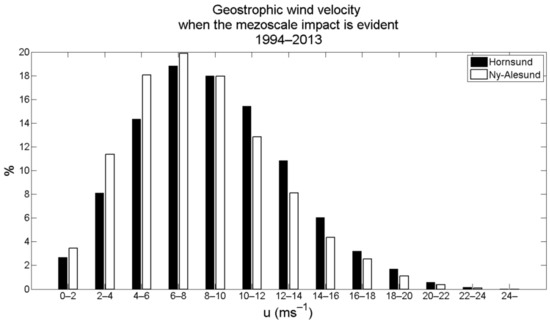
Figure 5.
The distribution of large-scale wind speed from the NCEP/NCAR reanalysis at Hornsund and Ny-Ålesund stations when the mesoscale land-sea breeze type circulation was recorded, 1994–2013. Black—Hornsund, white—Ny-Ålesund.
Kongsfjorden and Hornsund are two independent fjords whose entrances are located on the west coast of Spitsbergen, but arranged in a slightly different direction and the wind blowing along the fjords has a different direction. As described in [13], the circulation of the land-sea breeze type in the western Spitsbergen fjords is determined by the temperature difference between the cold glaciers surrounding the fjords and the warmer waters flowing west of the island. The air temperature gradient on a large scale is generally on the east-west line, while the Kongsfjorden is positioned differently and the wind speed is lower.
The Hornsund fjord was analysed in more detail. The axis of the fjord is situated along the longitudinal lines, and exactly on the west side there are warm open waters while on the east side the land is covered with cold glaciers. The Hornsund fjord is dominated by the eastern winds [15,24]. During the 20 years under discussion, they account for 94% of observations, while the prevalence of such circulation in the Hornsund research station is confirmed by previous studies and their published results. Furthermore, 51.5% of the eastern winds measured at the station were found to be caused by the mesoscale effect of land-sea breeze type circulation. Meanwhile, 43% of all wind data collected from the NCEP/NCAR reanalysis for the same period are cases of eastern winds (57% are cases of western winds). While a large-scale wind was western, 85.35% of the situation was eastern wind in the station (i.e., we could notice that the wind direction measured in the station was opposite to the large-scale one and was oriented from the cold glacier surface towards the warmer ocean water). Thus, it appears that for 48.6% of all data from reanalysis, the mesoscale factor had a dominant influence on the wind direction at the station, i.e., the land-sea breeze type circulation was noticed.
Figure 6 shows that not all cases where easterly winds were measured at the Hornsund station are related to the mesoscale factor, i.e., land-sea breeze type circulation. Weak winds of less than 2 ms−1 in only half of the cases are due to the mesoscale factor, and the remaining measurements indicate an easterly local wind direction consistent with the easterly direction of the large-scale wind. However, stronger winds are more often than not the result of this factor. In the case of winds with speeds of 12–20 ms−1, as many as 94% of the cases (98% in the speed range of 14–16 ms−1) resulted from this factor, since at the time the large-scale wind was in the opposite direction (i.e., westerly).
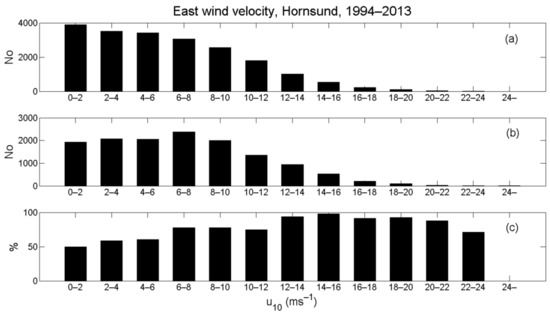
Figure 6.
Number of east winds measured at Hornsund station for the years 1994–2013 subdivided by speed. (a) All measurements showing the east wind. (b) Measurements showing the wind from east when the land-sea breeze type circulation is observed on the basis of the difference in wind directions. (c) Percentage of winds from east when a mesoscale land-sea breeze observed, in total measured winds from east for each wind speed range.
3.3. Near Zero Large-Scale Wind
So far, it has been shown that the land-sea breeze type circulation is easiest to observe when the direction of the local wind resulting mostly from the difference in temperature between a cold glacier and the warmer surface of the ocean is eastern while the large-scale wind is western. The dominance of mesoscale influence can also be noticed in the case of western wind directions. 13% of all data from the analysed period represent conditions wherein both the large-scale wind and the wind measured in the Hornsund station blow from western sector. In such situations, as much as 75.5% of the cases point to a factor that influences the wind speed since the speed measured in the station is smaller than the wind resulting from the large-scale pressure field following reanalysis. In some cases of large-scale winds from western sector, the mesoscale influence does not affect decisively the change in the direction of the blowing wind but significantly reduces its speed. The averaged difference between the one measured in Hornsund and the large-scale wind speed in our calculations is 4.6 ms−1. The distribution of the difference in speed from the reanalysis and speed measured at the Hornsund station when the winds in both scales were western is presented on Figure 7. At the same time, it should be noted that earlier in this study over 85% of large-scale western winds were shown to be influenced by local factors and had a different direction at the station.

Figure 7.
The histogram shows the distribution of the difference in wind speed from the reanalysis and speed measured at the Hornsund station for the period 1994–2013 when the winds in both scales were western.
For the analysed period, only 1.5% of the data describing the large scale wind are those representing near-zero velocity, i.e., in the velocity range of 0 to 1 ms−1. Therefore, the range of 0 to 2 ms−1, which includes 5.4% of the reanalysis data, was adopted for further calculation. Figure 8 shows that easterly winds dominate in Hornsund at the time, accounting for 69.4% of cases. It is therefore possible to see the influence of the mesoscale factor on the synoptic situation. The maximum wind speed observed during the analysed period was 19 ms−1, even though the large-scale wind field implied winds close to zero. Moreover, the average speed of easterly winds in such situation is 5 ms−1. The remaining 24.4% of situations where there is a westerly wind observation with a large-scale wind near zero cannot be ignored. However, such situations are clearly uncommon and their average speed is 3.4 ms−1, which is also significantly lower than that of the easterly winds. 6.2% of cases are calm (Figure 8).
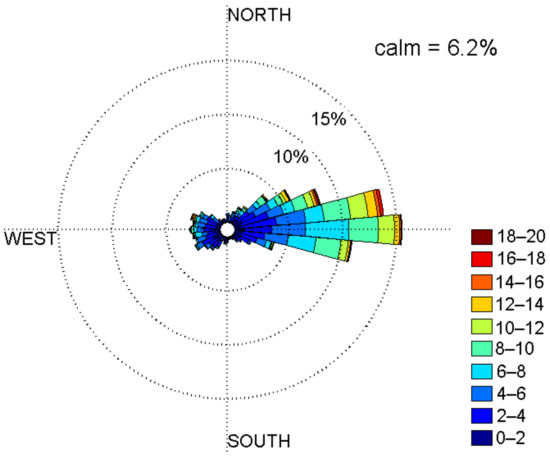
Figure 8.
Wind rose showing wind from Hornsund station for the 1994–2013 when the large-scale wind velocity is 0–2 ms−1.
3.4. Air Temperature and Its Influence
Using data from the Era-Interim reanalysis, a 2 m air temperature difference was calculated for a point in the nearest surroundings of the Hornsund research station, a point about 60 km away towards the open ocean along a line tracing the axis of the fjord, a point nearby at the base in Ny-Ålesund, and a corresponding point at sea (indicated in Figure 1). The temperature differences were contrasted with the corresponding differences in wind velocity measured at the stations and the resulting wind from the large-scale pressure field (Figure 9) at the time when the mesoscale land-sea breeze type circulation was observed.
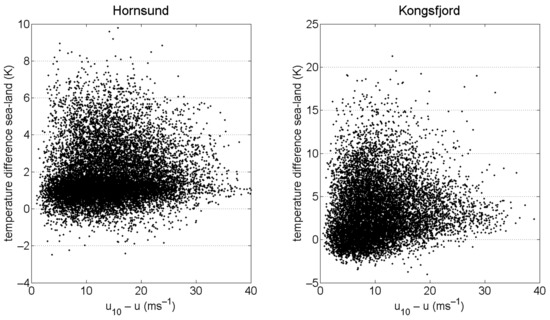
Figure 9.
Graphs representing dependence of the air temperature difference at the station and over the open sea and the difference of large-scale and local wind velocity in Hornsund (left panel) and Kongsfjorden (right panel) when the mesoscale land-sea breeze type circulation was observed between 1994 and 2013.
In the situations analysed, wind speed does not depend linearly on this temperature difference. In the great majority of cases, and in agreement with the supposition that this is a factor resulting from the temperature difference influencing the atmospheric circulation, the temperature above water was higher than that above the island. In Kongsfjorden, there were 1545 cases with the opposite situation, i.e., the air temperature over water was lower than over land, which is 13.8% of all captured (by observing change in the wind direction) land-sea breeze type circulation events. In Hornsund, 626 such cases were recorded which respectively represent only 4.4%, a rather small fraction of the total of land-sea breeze type circulation events detected.
Table 1 compiles some temperature values that describe the situation when it is warmer over land than over water, and the land-sea breeze type circulation is noticeable. The data were also analysed in terms of the seasons in which this “opposite” situation occurred and the air was warmer over land than over the sea especially in summer (JJA), accounting for 1.78% of all cases of land-sea breeze type circulation in Hornsund, and as much as 10.1% in Kongsfjorden. The proportion is lowest in winter (DJF) where it is 0.57% for Hornsund and only 0.43% for Kongsfjorden. The other two seasons are as follows: spring (MAM)—0.58% Hornsund and 0.80% Kongsfjorden; autumn (SON)—1.47% Hornsund and 2.45% Kongsfjorden. Such an uneven distribution over the seasons, which additionally differs in both fjords, is related to the influence of the ocean on climate in Hornsund and Kongsfjorden, causing the amplitude of annual air temperature to be smaller in Hornsund than in Kongsfjorden. We also know that the air temperature in summer is higher in Kongsfjorden than in Hornsund but reversed in winter [15].

Table 1.
Maximum, minimum and average temperature values over land and open water (and their differences) when a land-sea breeze type circulation is noticed and air temperature is lower over the ocean.
The few cases where large-scale and local wind directions indicate the dominant influence of a mesoscale factor and that it is unrelated to the temperature differences (i.e., over open water it is not warmer than over land) are rather difficult to explain by the mesoscale land-sea breeze type circulation. They can be caused by even smaller scale processes such as katabatic winds. In the case of Svalbard, where there are no very large plateaus that can be heated more effectively by solar radiation in summer, these phenomena are of lesser importance and of a smaller scale, but they do occur. It occurs more often in Kongsfjorden than in Hornsund since there are no such large glaciers east of the station in Hornsund. In addition, small-scale processes may occur more frequently in summer than in winter due to the uneven heating of land fragments locally, e.g., capes, peninsulas, mountainsides, etc. Small-scale processes should include not only katabatic winds, but also valley winds, adiabatic winds and other orography-related phenomena [25] that are smaller in scale and extent than mesoscale land-sea breeze type circulation.
The distribution of the atmospheric circulation patterns in situations where there is a land-sea breeze type circulation but with an opposite temperature according to the Era-Interim reanalysis (Figure 10), i.e., warmer over land than over the open water, is very similar to the distribution in all events of land-sea breeze type circulation (Figure 2). Most cases occurred during eastern and south-eastern circulation types. The largest clear deviation is the relatively larger number of measurements when the Niedzwiedz’s calendar reports that ridge or trough (Ka, Bc) has prevailed, during which there is no decisive pressure gradient and therefore small-scale processes are of utmost significance. These accounted for about 20% of the data discussed (22.2% in Hornsund, 19.7% in Kongsfjorden). Practically, this means that such cases account for less than 1% of all the events of land-sea breeze type circulation we observe at Hornsund.
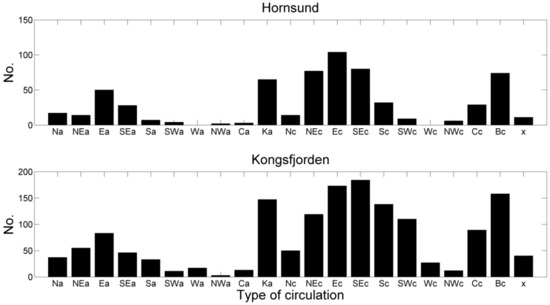
Figure 10.
Distribution of types of synoptic situations (circulation types) when the mesoscale effect was recorded in Hornsund and Ny-Ålesund on the basis of the difference in wind directions in West Spitsbergen fjords, but with temperature over open water being lower than over land.
The wind speed distribution plots from the NCEP/NCAR reanalysis data in both studied fjords (left panels on Figure 11) show that the large-scale situation (when there is land-sea breeze type circulation observable and lower temperature over the sea than land are similar to that covering all cases of land-sea breeze type circulation cases regardless of air temperature (Figure 9). The wind speed measured at the Hornsund station (right top panel in Figure 11) in the analysed situations is most often in the range 0–10 ms−1, which is 86.6%. In Kongsfjorden, as much as 48.5% are wind speed measurements of 2 ms−1 or less. It is important to note that this is only part of a small percentage of the data when the temperature difference over water and land did not correspond to the wind direction. At Hornsund, the wind blowing as a result of the mesoscale factor had higher speeds (Figure 4), mostly around 7 ms−1. In these situations, where the temperature is reversed and smaller scale processes play a major role, the wind speeds are lower. Wind speeds of no more than 6 ms−1 account for 53%.
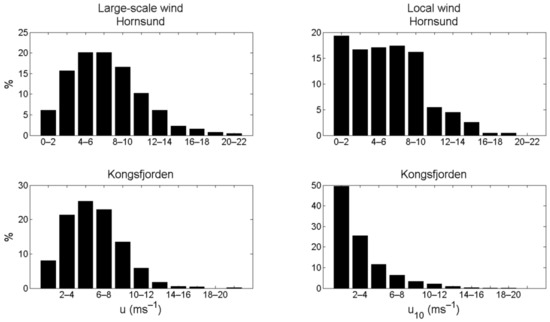
Figure 11.
The distribution of large-scale wind speed from the NCEP/NCAR reanalysis and local wind speed from stations in Hornsund and Ny-Ålesund when the mesoscale factor visibly dominated the large-scale one, but with temperature over open water being lower than over land between 1994 and 2013.
4. Discussion and Conclusions
Climatologically, Spitsbergen is located in the easterly wind zone, and it is thus not surprising that the dominant wind direction at the meteorological stations on the island is easterly (Figure 12). However, if we look at the wind rose drawing made from the NCEP/NCAR reanalysis data, the dominance of the eastern sector over others is not so clear. Taking a look at the mean pressure field derived from the Era-Interim reanalysis data in Figure 13 (with a much denser grid than NCEP/NCAR), it also shows no dominance of the eastern sector wind, a dominance that has been corroborated (as proven by 94% of the measurements during the investigated period). This is due to the fact that wind directions are influenced by smaller scale phenomena in addition to the pressure gradients of the large-scale field. Comparison of data from Svalbard stations (Bjørnøya, Hopen and Ny-Ålesund) with NCEP/NCAR and ERA-Interim reanalysis by [26] also shows wind direction indices that are characterized by different tendencies, and are caused by local factors. For Svalbard these trends are spatially varying.
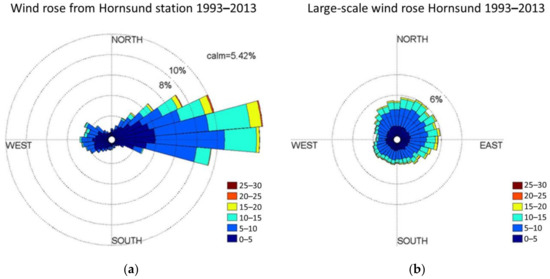
Figure 12.
Local wind rose for (a) Hornsund station for the years 1992–2013, and (b) large-scale wind rose (from NCEP/NCAR reanalysis) interpolated for the position of the Hornsund station for the years 1993–2013 [13].
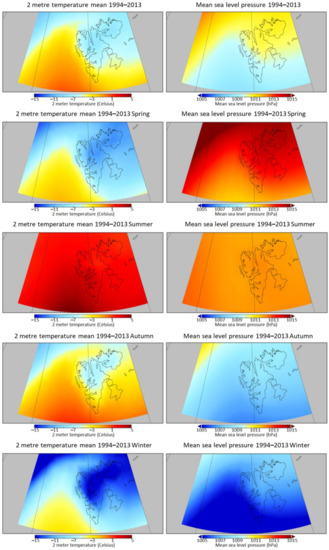
Figure 13.
Distribution of mean 2 m temperature (top left panel) and mean sea level pressure (top right panel) in Svalbard region from 1994 to 2013 and below the distributions in the following seasons—spring, summer, autumn, and winter. Data derived from Era-Interim reanalysis.
We argue that the determining factor responsible for increasing the frequency of easterly winds at Hornsund and other eastern Spitsbergen stations is the mesoscale land-sea breeze type circulation [13]. This is caused by the temperature difference between the cold east of the island and the warm waters west of the island. Since the West Spitsbergen Current, carrying warm Atlantic water from the south, flows through the region we study [14], the waters west of Spitsbergen do not freeze. It happens that sea ice that occurs coming in from the north or south from the Storfjordrenna results in lower air temperature. However, these are situations where the influence on the mesoscale circulation is negligible, except for episodic exceptions. Figure 13 (left panel) shows the averaged air temperature field based on data from the Era-Interim reanalysis for the study period. The mean air temperature is significantly lower over land than over water. This applies to both the mean of the entire period and the individual seasons during that time. Of course, the average field is not indicative of all instantaneous air temperature distributions. In Figure 9, we show the differences in air temperature over sea and land for all measurements whereby the land-sea breeze type circulation events were noticed. At Hornsund, only 4.4% of these differences are negative. The greatest number of negative differences were recorded during the summer months. In summer, large areas of land are free of snow and ice, which makes it warmer, and at the same time it happens that the West Spitsbergen Current carries ice fields that have drifted around the Sørkapp [27], causing the air temperature gradient to be in the opposite direction-higher temperature over land, lower over sea. For this reason, the probability of a mesoscale breeze occurring in summer is the lowest [13]. In this case, changes in wind direction relative to the large-scale winds may be induced by smaller-scale impacts caused by uneven ground heating. This can also be seen in the mean sea level pressure distributions at different times of the year (Figure 13). The difference in mean sea level pressure in summer is smaller than in other seasons.
The breeze pattern cannot be distinguished from the actual wind field pattern since this mesoscale effect affects the pressure field and the field always. Only a matter of proper choice of the model grid gives the possibility to observe different scales of wind fields. It can be a wind field resulting only from the global pressure distribution or a field that takes into account the local orography. In this case, we look at the mesoscale effect accounting for the east-west air temperature difference, which is evident in the Era-Interim reanalysis data with a 0.125° × 0.125° spatial resolution, regardless of season.
A compilation of the distributions of 10 m wind speed and direction and air temperature at a height of 2 m from the Era-Interim reanalysis data at the time of observing the land-sea breeze type mesoscale circulation is shown in Figure 14. These graphs represent the situation at different times of the year and during different observed circulation types according to the Niedźwiedź’s Calendar. The distributions show that the data from a dense grid model such as Era-Interim 0.125° × 0.125° reproduce the u component of the wind as measured, i.e., the local wind measured at the stations blew from the east, opposite to the large-scale wind. The air temperature distributions are also consistent with the conclusion that the occurrence of a breeze type circulation is usually determined by the air temperature difference. However, Figure 14c shows a situation on one day in the summer of 1995, when the air temperature over the island was higher than over the open water, but still a mesoscale land-sea breeze type circulation was observed, and the type of circulation that occurred at that time was Sec, which is one of the most frequently found when a breeze circulation was observed despite the higher temperature in the east (Figure 10). Southwest of Spitsbergen there is a large area of high-temperature air (>5 °C), and low temperatures persist over the eastern part of the island (and further east as well), which ultimately results in the mesoscale effect being maintained despite a partially summer-heated land surface.
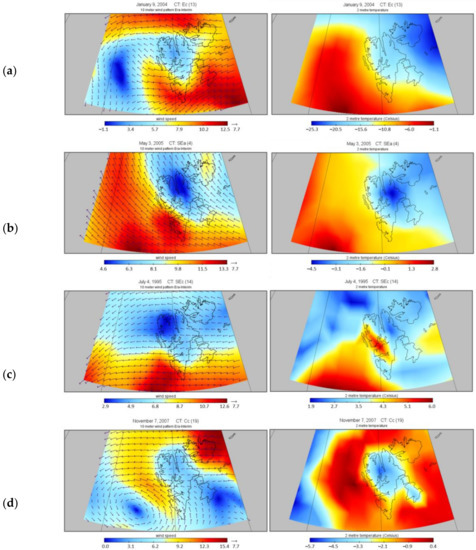
Figure 14.
Distribution of 10 m wind speed and direction (left panels) and 2 m air temperature (right panels) obtained from Era-Interim with grid 0.125° × 0.125°. The following rows correspond to land-sea breeze type circulation events in consecutive seasons: (a) 09.01.2004, CT: Ec; (b) 03.05.2005, CT: SEa; (c) 4.07.1995, CT: SEc; (d) 7.11.2007, CT: Cc.
An analysis of wind data in conjunction with Niedzwiedz’s Calendar (Figure 2), which defines the direction and type of air mass circulation on the basis of synoptic maps, leads to the conclusion that the mesoscale breeze type circulation most often occurs in synoptic situations, causing eastern cyclonic circulation (Ec) as well as southeasterly and northeasterly cyclonic circulation (SEc, NEc). The occurrence of breeze type circulation is also the cause of numerous cases of easterly anticyclonic circulations according to Niedzwiedz’s Calendar. In Figure 3, it can be seen that we recorded a change in local wind direction relative to the large-scale wind direction in as much as 60% of the SEc circulation and in close to 40% of the Ea, SEa, NEc, Ec, and Sc circulations. In westerly circulations it is not possible to determine the occurrence of a mesoscale land-sea breeze type circulation since a local westerly wind means either that kind of circulation did not exist or that the gradient of the large-scale pressure field was so large that the land-sea breeze type circulation could not eventuate. Nevertheless, in this case the temperature gradient also affects the wind field and reduces its speed. The influence of atmospheric circulation on the spatial pattern of air temperature is not homogenous and significant differences were observed between onshore and inland parts of Svalbard [28], as well as changes throughout the year.
The mesoscale impact is most easily detectable when the synoptic situation is such that it gives eastern inflows in the Svalbard area. At the same time, the whole region comprises the area where the large-scale eastern circulation is dominant, thereby rendering the mesoscale eastern influence noticeable using the wind direction parameter even if only for a few days of the year. However, we have shown that the mesoscale effect on the wind field is noticeable in various ways in different situations. If this is not evident by the change in wind direction measured at the meteorological station relative to the large-scale wind, it is evident in the wind speed, which is reduced for westerly winds by the influence of the mesoscale effect. The influence of the mesoscale land-sea breeze circulation is also evident for weak winds, which often turn out to be much stronger at the station than at the large scale. Figure 7 shows the distribution of differences between the west wind speed values from the large-scale model and the speed measured in Hornsund. The distribution is asymmetric, indicating lower westerly wind speeds at Hornsund that would have been implied by the large-scale pressure gradients.
East winds are induced or amplified by the mesoscale effect of the air temperature gradient. The most commonly recorded wind speeds is about 7 ms−1 even though the mesoscale effect can also be found in very strong winds of 22 ms−1. Such high speeds are possibly caused by the mesoscale land-sea breeze type circulation effects, but the phenomenon may also be further enhanced by orography (wind channelling, fen effects, katabatic winds, etc.), which cannot be ignored. The large influence of katabatic winds on climate formation in polar region was indicated by [29], showing also that winds of this type, such as the mesoscale land-sea breeze type circulation events analysed in this work, are much more frequent in winter (up to 55% per month) than in summer (no more than 11%).
In [13], we were able to demonstrate that the phenomenon is mesoscale and occurs simultaneously within a long distance along the west coast of Spitsbergen. However, we still do not know how many of these are cases of small-scale processes. In some cases, we have observed that the air temperature over the water west of the station is lower than that near the station and a westerly wind is deduced from the large-scale pressure field, yet an easterly wind is measured locally. We believe that small-scale processes such as katabatic, downslope, valley winds, or others, which result from local heating of the land surface by solar radiation, are responsible for this. This occurs mainly in summer.
The prevalence of easterly winds in the studied area causes the current to turn northward (Ekman flow, e.g., [2]), so that the mesoscale circulation is one of the reasons for this flow. This implies that the mesoscale effect, which has a significant influence on wind direction and speed, is an important factor with effect on water flow in the West Spitsbergen Current region. This will be the subject of a future study.
During the study period, a few degrees of warming (about 4°C according to [14]) did not significantly change the frequency of the land-sea breeze type circulation. Changes to the Arctic climate do not affect this local mesoscale effect since there are still glaciers on land and warmer water to the west of Spitsbergen, which still ensure a temperature difference that generates airflow. It is possible that with further climate warming, when glaciers will disappear or their area will be only a percentage of the present one, the phenomenon will not occur.
Author Contributions
Conceptualization, M.K. and T.P.; data curation, M.K.; formal analysis, M.K.; funding acquisition, T.P.; investigation, M.K.; methodology, M.K. and T.P.; project administration, T.P.; resources, M.K.; software, M.K.; supervision, M.K.; validation, M.K. and T.P.; visualization, M.K.; writing—original draft, M.K.; writing—review and editing, M.K. and T.P. All authors have read and agreed to the published version of the manuscript.
Funding
This research received no external funding.
Institutional Review Board Statement
Not applicable.
Informed Consent Statement
Not applicable.
Data Availability Statement
No new data were created or analyzed in this study. Data sharing is not applicable to this article.
Acknowledgments
We thank Tomasz Wawrzyniak and Hornsund Polish Polar Station staff for the meteorological data used in this paper. We also thank Marion Maturilli from Alfred Wegener Institute, Helmholtz Centre for Polar and Marine Research, Potsdam, Germany, for the Kongsfjord data.
Conflicts of Interest
The authors declare no conflict of interest.
References
- Esau, I.; Argentini, S.; Przybylak, R.; Repina, I.; Sjöblom, A. Svalbard Meteorology. Adv. Meteorol. 2012, 2012, 1–3. [Google Scholar] [CrossRef]
- Goszczko, I.; Ingvaldsen, R.B.; Onarheim, I.H. Wind-Driven Cross-Shelf Exchange—West Spitsbergen Current as a Source of Heat and Salt for the Adjacent Shelf in Arctic Winters. J. Geophys. Res. Oceans. 2018, 123, 2668–2696. [Google Scholar] [CrossRef]
- Polyakov, I.V.; Walsh, J.; Kwok, R. Recent Changes of Arctic Multiyear Sea Ice Coverage and the Likely Causes. Bull. Am. Meteorol. Soc. 2012, 93, 145–151. [Google Scholar] [CrossRef]
- Alkama, R.; Koffi, E.N.; Vavrus, S.J.; Diehl, T.; Francis, J.A.; Stroeve, J.; Forzieri, G.; Vihma, T.; Cescatti, A. Wind amplifies the polar sea ice retreat. Environ. Res. Lett. 2020, 15, 124022. [Google Scholar] [CrossRef]
- Holliday, N.P.; Bersch, M.; Berx, B.; Chafik, L.; Cunningham, S.; Florindo-López, C.; Hátún, H.; Johns, W.; Josey, S.A.; Larsen, K.M.H.; et al. Ocean circulation causes the largest freshening event for 120 years in eastern subpolar North Atlantic. Nat. Commun. 2020, 11, 1–15. [Google Scholar] [CrossRef]
- Mioduszewski, J.; Vavrus, S.; Wang, M. Diminishing Arctic Sea Ice Promotes Stronger Surface Winds. J. Clim. 2018, 31, 8101–8119. [Google Scholar] [CrossRef]
- Hughes, M.; Cassano, J.J. The climatological distribution of extreme Arctic winds and implications for ocean and sea ice processes. J. Geophys. Res. Atmos. 2015, 120, 7358–7377. [Google Scholar] [CrossRef]
- Fraser, N.J.; Skogseth, R.; Nilsen, F.; Inall, M.E. Circulation and exchange in a broad Arctic fjord using glider-based observations. Polar Res. 2018, 37, p1. [Google Scholar] [CrossRef] [Green Version]
- Repina, I.A.M. Obukhov Institute of Atmospheric Physics RAS; M.V. Lomonosov Moscow State University The sea surface and the katabatic flow interaction in the fjords of Spitsbergen. Sovrem. Probl. Distantsionnogo Zondirovaniya Zemli Kosm. 2018, 15, 217–228. [Google Scholar] [CrossRef]
- Spall, M.A.; Jackson, R.H.; Straneo, F. Katabatic Wind-Driven Exchange in Fjords. J. Geophys. Res. Oceans 2017, 122, 8246–8262. [Google Scholar] [CrossRef]
- Sundfjord, A.; Albretsen, J.; Kasajima, Y.; Skogseth, R.; Kohler, J.; Nuth, C.; Skarðhamar, J.; Cottier, F.; Nilsen, F.; Asplin, L.; et al. Effects of glacier runoff and wind on surface layer dynamics and Atlantic Water exchange in Kongsfjorden, Svalbard; a model study. Estuarine Coast. Shelf Sci. 2017, 187, 260–272. [Google Scholar] [CrossRef]
- Cisek, M.; Petelski, T.; Zielinski, T.; Makuch, P.; Pakszys, P.; Rozwadowska, A.; Markuszewski, P. Aerosol Optical Depth variations due to local breeze circulation in Kongsfjorden, Spitsbergen. Oceanologia 2017, 59, 422–430. [Google Scholar] [CrossRef]
- Kitowska, M.; Makuch, P.; Petelski, T.; Piskozub, J. The influence of mesoscale l and–sea breeze circulation on local wind climatology in the Svalbard fjords of Kongsfjorden and Hornsund. Int. J. Clim. 2021, 41, 832–841. [Google Scholar] [CrossRef]
- Walczowski, W.; Piechura, J. Influence of the West Spitsbergen Current on the local climate. Int. J. Clim. 2011, 31, 1088–1093. [Google Scholar] [CrossRef]
- Cisek, M.; Makuch, P.; Petelski, T. Comparison of meteorological conditions in Svalbard fjords: Hornsund and Kongsfjorden. Oceanologia 2017, 59, 413–421. [Google Scholar] [CrossRef]
- NCEP. Reanalysis Data Provided by the NOAA/OAR/ESRL PSD, Boulder, CO, USA. Available online: https://www.esrl.noaa.gov/psd/ (accessed on 20 May 2018).
- NOAA. High Resolution SST Data Provided by the NOAA/OAR/ESRL PSD, Boulder, CO, USA. Available online: https://www.esrl.noaa.gov/psd/ (accessed on 20 May 2018).
- Niedźwiedź, T. Calendar of Circulation Types for the Territory of Spitsbergen. 2013. Available online: http://klimat.wnoz.us.edu.pl/#!/podstrony/kalendarztn (accessed on 10 January 2021).
- Łupikasza, E.B.; Niedźwiedź, T. The Influence of Mesoscale Atmospheric Circulation on Spitsbergen Air Temperature in Periods of Arctic Warming and Cooling. J. Geophys. Res. Atmos. 2019, 124, 5233–5250. [Google Scholar] [CrossRef]
- Maturilli, M.; Herber, A.; König-Langlo, G. Climatology and time series of surface meteorology in Ny-Ålesund, Svalbard. Earth Syst. Sci. 2013, 5, 155–163. [Google Scholar] [CrossRef] [Green Version]
- Kalnay, E.; Kanamitsu, M.; Kistler, R.; Collins, W.; Deaven, D.; Gandin, L.; Iredell, M.; Saha, S.; White, G.; Woollen, J.; et al. The NCEP/NCAR 40-Year Reanalysis Project. Bull. Am. Meteorol. Soc. 1996, 77, 437–471. [Google Scholar] [CrossRef] [Green Version]
- Dee, D.P.; Uppala, S.M.; Simmons, A.J.; Berrisford, P.; Poli, P.; Kobayashi, S.; Andrae, U.; Balmaseda, M.A.; Balsamo, G.; Bauer, P.; et al. The ERA-Interim reanalysis: Configuration and performance of the data assimilation system. Q. J. Roy. Meteor. Soc. 2011, 137, 553–597. [Google Scholar] [CrossRef]
- Demchev, D.M.; Kulakov, M.Y.; Makshtas, A.P.; Makhotina, I.A.; Fil’Chuk, K.V.; Frolov, I.E. Verification of ERA-Interim and ERA5 Reanalyses Data on Surface Air Temperature in the Arctic. Russ. Meteorol. Hydrol. 2020, 45, 771–777. [Google Scholar] [CrossRef]
- Marsz, A.; Styszyńska, A. Climate and Climate Change at Hornsund, Svalbard; Marsz, A.A., Styszyńska, A., Eds.; The Publishing House of Gdynia Maritime University: Gdynia, Poland, 2013; 402p, ISBN 978-83-7421-191-8. [Google Scholar]
- Esau, I.; Repina, I. Wind Climate in Kongsfjorden, Svalbard, and Attribution of Leading Wind Driving Mechanisms through Turbulence-Resolving Simulations. Adv. Meteorol. 2012, 2012, 1–16. [Google Scholar] [CrossRef]
- Pilguj, N.; Kolendowicz, L.; Kryza, M.; Migała, K.; Czernecki, B. Temporal changes in wind conditions at Svalbard for the years 1986–2015. Geogr. Ann. Ser. A Phys. Geogr. 2018, 101, 136–156. [Google Scholar] [CrossRef]
- Promińska, A.; Cisek, M.; Walczowski, W. Kongsfjorden and Hornsund hydrography–comparative study based on a multiyear survey in fjords of west Spitsbergen. Oceanologia 2017, 59, 397–412. [Google Scholar] [CrossRef]
- Przybylak, R.; Araźny, A.; Ulandowska-Monarcha, P. The influence of atmospheric circulation on the spatial diversity of air temperature in the area of Forlandsundet (NW Spitsbergen) during 2010–2013. Int. J. Clim. 2018, 38, 230–251. [Google Scholar] [CrossRef]
- Nylen, T.H.; Fountain, A.G.; Doran, P.T. Climatology of katabatic winds in the McMurdo dry valleys, southern Victoria Land, Antarctica. J. Geophys. Res. Space Phys. 2004, 109. [Google Scholar] [CrossRef] [Green Version]
Publisher’s Note: MDPI stays neutral with regard to jurisdictional claims in published maps and institutional affiliations. |
© 2021 by the authors. Licensee MDPI, Basel, Switzerland. This article is an open access article distributed under the terms and conditions of the Creative Commons Attribution (CC BY) license (https://creativecommons.org/licenses/by/4.0/).